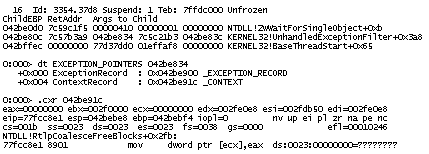One ofmistakes beginners make is trusting WinDbg !analyze or kv commandsdisplaying stack trace.WinDbg is only a tool, sometimes information necessary to get correct stack trace is missing and therefore some critical thought is required to distinguish between correct and incorrect stack traces. I call this patternIncorrect Stack Trace.Incorrect stack traces usually
- Have WinDbg warning: “Following frames may be wrong”
- Don’t have the correct bottomframe like kernel32!BaseThreadStart(in user-mode)
- Have function calls that don’t make any sense
- Have strange looking disassembled function code or code that doesn’t make any sense from compiler perspective
- Have ChildEBP and RetAddr addresses that don’t make any sense
Consider the following stack trace:
0:011> k
ChildEBP RetAddr
WARNING: Frame IP not in any known module. Following frames may be wrong.
0184e434 7c830b10 0×184e5bf
0184e51c 7c81f832 ntdll!RtlGetFullPathName_Ustr+0×15b
0184e5f8 7c83b1dd ntdll!RtlpLowFragHeapAlloc+0xc6a
00099d30 00000000 ntdll!RtlpLowFragHeapFree+0xa7
Here we have almost allattributes of the wrong stack trace. At the first glance it looks like some heap corruption happened (runtime heap alloc and free functions are present) but if you give it second thought you would see that low fragmentation heap Free function shouldn’t call low fragmentation heapAlloc function and the latter shoudn’tquery full path name. That doesn’t make any sense.
What we should do here? Look at raw stack and try to build the correct stack trace ourselves. In our case this is very easy. We need to traverse stack frames from BaseThreadStart+0×34 until we don’t find any function call or reach the top. When functions are called (no optimization, most compilers) EBP registers are linked together as explained on slide 13 here:
Practical Foundations of Debugging (6.1)
0:011> !teb
TEB at 7ffd8000
ExceptionList: 0184ebdc
StackBase: 01850000
StackLimit: 01841000
SubSystemTib: 00000000
FiberData: 00001e00
ArbitraryUserPointer: 00000000
Self: 7ffd8000
EnvironmentPointer: 00000000
ClientId: 0000061c . 00001b60
RpcHandle: 00000000
Tls Storage: 00000000
PEB Address: 7ffdf000
LastErrorValue: 0
LastStatusValue: c0000034
Count Owned Locks: 0
HardErrorMode: 0
0:011> dds 01841000 01850000
01841000 00000000
…
…
…
0184eef0 0184ef0c
0184eef4 7615dff2 localspl!SplDriverEvent+0×21
0184eef8 00bc3e08
0184eefc 00000003
0184ef00 00000001
0184ef04 00000000
0184ef08 0184efb0
0184ef0c 0184ef30
0184ef10 7615f9d0 localspl!PrinterDriverEvent+0×46
0184ef14 00bc3e08
0184ef18 00000003
0184ef1c 00000000
0184ef20 0184efb0
0184ef24 00b852a8
0184ef28 00c3ec58
0184ef2c 00bafcc0
0184ef30 0184f3f8
0184ef34 7614a9b4 localspl!SplAddPrinter+0×5f3
0184ef38 00c3ec58
0184ef3c 00000003
0184ef40 00000000
0184ef44 0184efb0
0184ef48 00c117f8
…
…
…
0184ff28 00000000
0184ff2c 00000000
0184ff30 0184ff84
0184ff34 77c75286 RPCRT4!LRPC_ADDRESS::ReceiveLotsaCalls+0×3a
0184ff38 0184ff4c
0184ff3c 77c75296 RPCRT4!LRPC_ADDRESS::ReceiveLotsaCalls+0×4a
0184ff40 7c82f2fc ntdll!RtlLeaveCriticalSection
0184ff44 000de378
0184ff48 00097df0
0184ff4c 4d2fa200
0184ff50 ffffffff
0184ff54 ca5b1700
0184ff58 ffffffff
0184ff5c 8082d821
0184ff60 0184fe38
0184ff64 00097df0
0184ff68 000000aa
0184ff6c 80020000
0184ff70 0184ff54
0184ff74 80020000
0184ff78 000b0c78
0184ff7c 00a50180
0184ff80 0184fe38
0184ff84 0184ff8c
0184ff88 77c5778f RPCRT4!RecvLotsaCallsWrapper+0xd
0184ff8c 0184ffac
0184ff90 77c5f7dd RPCRT4!BaseCachedThreadRoutine+0×9d
0184ff94 0009c410
0184ff98 00000000
0184ff9c 00000000
0184ffa0 00097df0
0184ffa4 00097df0
0184ffa8 00015f90
0184ffac 0184ffb8
0184ffb0 77c5de88 RPCRT4!ThreadStartRoutine+0×1b
0184ffb4 00088258
0184ffb8 0184ffec
0184ffbc 77e6608b kernel32!BaseThreadStart+0×34
0184ffc0 00097df0
0184ffc4 00000000
0184ffc8 00000000
0184ffcc 00097df0
0184ffd0 8ad84818
0184ffd4 0184ffc4
0184ffd8 8980a700
0184ffdc ffffffff
0184ffe0 77e6b7d0 kernel32!_except_handler3
0184ffe4 77e66098 kernel32!`string’+0×98
0184ffe8 00000000
0184ffec 00000000
0184fff0 00000000
77c5de6d RPCRT4!ThreadStartRoutine
0184fff8 00097df0
0184fffc 00000000
01850000 00000008
Next we need to use custom k command and specify base pointer. In our case the last found stack address that links EBP pointers is 0184eef0:
0:011> k L=0184eef0
ChildEBP RetAddr
WARNING: Frame IP not in any known module. Following frames may be wrong.
0184eef0 7615dff2 0×184e5bf
0184ef0c 7615f9d0 localspl!SplDriverEvent+0×21
0184ef30 7614a9b4 localspl!PrinterDriverEvent+0×46
0184f3f8 761482de localspl!SplAddPrinter+0×5f3
0184f424 74067c8f localspl!LocalAddPrinterEx+0×2e
0184f874 74067b76 SPOOLSS!AddPrinterExW+0×151
0184f890 01007e29 SPOOLSS!AddPrinterW+0×17
0184f8ac 01006ec3 spoolsv!YAddPrinter+0×75
0184f8d0 77c70f3b spoolsv!RpcAddPrinter+0×37
0184f8f8 77ce23f7 RPCRT4!Invoke+0×30
0184fcf8 77ce26ed RPCRT4!NdrStubCall2+0×299
0184fd14 77c709be RPCRT4!NdrServerCall2+0×19
0184fd48 77c7093f RPCRT4!DispatchToStubInCNoAvrf+0×38
0184fd9c 77c70865 RPCRT4!RPC_INTERFACE::DispatchToStubWorker+0×117
0184fdc0 77c734b1 RPCRT4!RPC_INTERFACE::DispatchToStub+0xa3
0184fdfc 77c71bb3 RPCRT4!LRPC_SCALL::DealWithRequestMessage+0×42c
0184fe20 77c75458 RPCRT4!LRPC_ADDRESS::DealWithLRPCRequest+0×127
0184ff84 77c5778f RPCRT4!LRPC_ADDRESS::ReceiveLotsaCalls+0×430
0184ff8c 77c5f7dd RPCRT4!RecvLotsaCallsWrapper+0xd
Stack traces make more sense now but we don’t see BaseThreadStart+0×34. By default WinDbg displays only certain amount of function calls (stack frames) so we need to specify stack frame count, for example, 100:
0:011> k L=0184eef0 100
ChildEBP RetAddr
WARNING: Frame IP not in any known module. Following frames may be wrong.
0184eef0 7615dff2 0×184e5bf
0184ef0c 7615f9d0 localspl!SplDriverEvent+0×21
0184ef30 7614a9b4 localspl!PrinterDriverEvent+0×46
0184f3f8 761482de localspl!SplAddPrinter+0×5f3
0184f424 74067c8f localspl!LocalAddPrinterEx+0×2e
0184f874 74067b76 SPOOLSS!AddPrinterExW+0×151
0184f890 01007e29 SPOOLSS!AddPrinterW+0×17
0184f8ac 01006ec3 spoolsv!YAddPrinter+0×75
0184f8d0 77c70f3b spoolsv!RpcAddPrinter+0×37
0184f8f8 77ce23f7 RPCRT4!Invoke+0×30
0184fcf8 77ce26ed RPCRT4!NdrStubCall2+0×299
0184fd14 77c709be RPCRT4!NdrServerCall2+0×19
0184fd48 77c7093f RPCRT4!DispatchToStubInCNoAvrf+0×38
0184fd9c 77c70865 RPCRT4!RPC_INTERFACE::DispatchToStubWorker+0×117
0184fdc0 77c734b1 RPCRT4!RPC_INTERFACE::DispatchToStub+0xa3
0184fdfc 77c71bb3 RPCRT4!LRPC_SCALL::DealWithRequestMessage+0×42c
0184fe20 77c75458 RPCRT4!LRPC_ADDRESS::DealWithLRPCRequest+0×127
0184ff84 77c5778f RPCRT4!LRPC_ADDRESS::ReceiveLotsaCalls+0×430
0184ff8c 77c5f7dd RPCRT4!RecvLotsaCallsWrapper+0xd
0184ffac 77c5de88 RPCRT4!BaseCachedThreadRoutine+0×9d
0184ffb8 77e6608b RPCRT4!ThreadStartRoutine+0×1b
0184ffec 00000000 kernel32!BaseThreadStart+0×34
Now stack trace looks much better.
- Dmitry Vostokov -
'Crash dump 불펌스페샬' 카테고리의 다른 글
| Crash Dump Analysis Patterns (Part 12) (0) | 2007.05.14 |
|---|---|
| Crash Dump Analysis Patterns (Part 10) (1) | 2007.05.14 |
| Crash Dump Analysis Patterns (Part 9a) (2) | 2007.05.14 |
| Crash Dump Analysis Patterns (Part 8) (0) | 2007.05.13 |
| Crash Dump Analysis Patterns (Part 6) (0) | 2007.05.13 |






